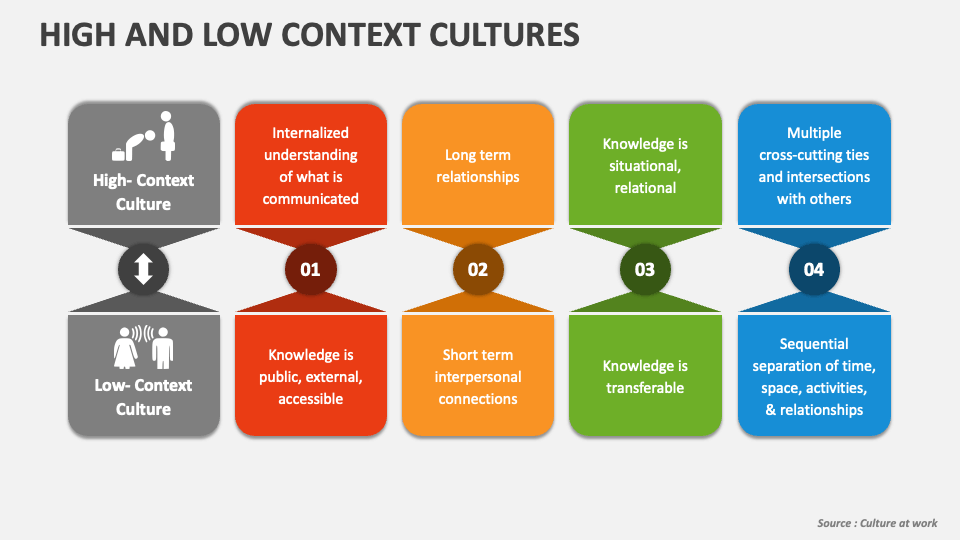Have you ever felt completely lost in a new country, despite speaking the language? Or maybe you’ve witnessed a seemingly simple interaction escalate into a heated argument between people from different cultures? These experiences highlight the importance of understanding cultural differences, particularly when it comes to communication styles. Enter the fascinating world of high-context and low-context cultures, a framework that offers a valuable lens through which to comprehend these variations.

Image: www.flowjournal.org
High-context and low-context cultures represent two distinct approaches to communication. They differ in how much information is explicitly stated versus implied or understood through shared cultural knowledge. Understanding these differences is crucial for effective communication, fostering cross-cultural understanding, and navigating the complexities of global interactions.
Defining High-Context and Low-Context Cultures
High-Context Culture
Think of high-context cultures as “reading between the lines.” Communication is heavily influenced by unspoken cues, social hierarchies, and shared cultural experiences. Meaning is often conveyed through gestures, tone of voice, facial expressions, and the context of the situation. In high-context cultures, individuals are highly attuned to subtle social cues and understand that explicit language may not always be necessary.
Examples of high-context cultures include:
- Japanese
- Korean
- Chinese
- Arab cultures
- Latin American cultures
Low-Context Culture
In contrast, low-context cultures prioritize direct communication. Communication is explicit, with clear and direct language used to convey meaning. The emphasis is on logical reasoning, objective facts, and precise language. In low-context cultures, people value explicit instructions and clear explanations, as reliance on shared knowledge or unspoken cues is minimal.
Examples of low-context cultures include:
- American
- German
- Scandinavian
- British
- Dutch

Image: www.collidu.com
Communication Styles: High vs. Low Context
High-Context Communication:
In high-context communication, the focus is on establishing strong interpersonal relationships and building trust before engaging in meaningful conversation. Harmony and avoiding conflict are highly valued. Key characteristics include:
- Indirect communication: Subtle cues and non-verbal expressions play a significant role in conveying meaning.
- Emphasis on relationships: Prioritizing existing social networks and relationships is crucial for communication.
- Context-specific: Communication is highly dependent on the context of the situation.
- Importance of nonverbal communication: Body language, tone of voice, and facial expressions are vital channels of communication.
Low-Context Communication:
Low-context communication prioritizes clarity and efficiency. It emphasizes individualistic values and a direct approach to conveying information. Key characteristics include:
- Direct communication: Clear and explicit language is used to express ideas and intentions.
- Emphasis on tasks and goals: Communication focuses on achieving practical objectives.
- Impersonal approach: Communication is primarily focused on the message itself, not on building personal relationships.
- Importance of written communication: Documents and written agreements are crucial for ensuring clarity and understanding.
Real-World Applications: Navigating Cultural Differences
The high-context/low-context framework has numerous real-world applications, particularly in international business, diplomacy, and intercultural communication. Here are a few examples:
Negotiations and Business Meetings:
In high-context cultures, negotiations often involve lengthy relationship-building phases, with significant attention paid to non-verbal cues and social etiquette. In contrast, low-context cultures typically prioritize clear, direct communication, with a focus on outlining specific terms and conditions.
Teamwork and Collaboration:
Effective teamwork in diverse cultural contexts requires acknowledging and adapting to different communication styles. High-context cultures may favor collective decision-making, while low-context cultures may prioritize individual contributions and clear task assignments.
Interpersonal Communication:
Building meaningful relationships in cross-cultural environments requires understanding the nuances of communication styles. In high-context cultures, direct criticism may be considered rude, while in low-context cultures, straightforward feedback is often appreciated.
The Challenges of Cultural Blending
While the high-context/low-context framework is helpful for understanding cultural differences, it’s important to remember that real-world experiences are often more complex. Cultures are rarely purely high-context or low-context. Individuals may exhibit varying degrees of high-context and low-context tendencies depending on the situation, their personal communication style, and the cultural context.
Furthermore, globalization and increased intercultural interaction are blurring the lines between these cultural categories. Individuals from different cultural backgrounds are increasingly adapting and learning from each other, fostering a blend of communication styles.
Tips for Effective Communication: Bridging the Gap
Here are some practical tips for navigating communication challenges across high-context and low-context cultures:
- Be mindful of nonverbal cues: Pay attention to body language, tone of voice, and facial expressions.
- Practice active listening: Listen attentively and clarify any ambiguity.
- Ask clarifying questions: Don’t hesitate to ask for clarification if you are unsure about the meaning of a message.
- Embrace cultural differences: Recognize and respect the unique communication styles and customs of other cultures.
- Seek opportunities for cultural exchange: Engage in cross-cultural interactions to gain deeper understanding and empathy.
High Context And Low Context Culture
Conclusion: Embracing the Rich Tapestry of Cultures
Understanding high-context and low-context cultures is a crucial step towards fostering effective communication and building strong cross-cultural relationships. By acknowledging and appreciating cultural differences, we can navigate the complexities of global interactions, promote understanding, and open doors to new possibilities. Embrace the rich tapestry of cultures and continue exploring the fascinating world of intercultural communication!






